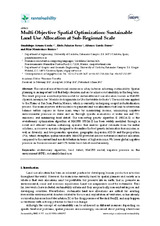Multi-Objective Spatial Optimization: Sustainable Land Use Allocation at Sub-Regional Scale
Autor
Azuara García, Guadalupe
Palacios Rosas, Efrén
García-Ferrer Porras, Alfonso
Montesinos Barrios, Pilar
Editor
MDPIFecha
2017Materia
Evolutionary algorithmFood deficit
MAUSS model
Negative pressure on the environment
Sustainable land uses
METS:
Mostrar el registro METSPREMIS:
Mostrar el registro PREMISMetadatos
Mostrar el registro completo del ítemResumen
The rational use of territorial resources is a key factor in achieving sustainability. Spatial
planning is an important tool that helps decision makers to achieve sustainability in the long term.
This work proposes a multi-objective model for sustainable land use allocation known as MAUSS
(Spanish acronym for “Modelo de Asignación de Uso Sostenible de Suelo”) The model was applied
to the Plains of San Juan, Puebla, Mexico, which is currently undergoing a rapid industrialization
process. The main objective of the model is to generate land use allocations that lead to a territorial
balance within regions in three main ways by maximizing income, minimizing negative
environmental pressure on water and air through specific evaluations of water use and CO2
emissions, and minimizing food deficit. The non-sorting genetic algorithm II (NSGA-II) is the
evolutionary optimization algorithm of MAUSS. NSGA-II has been widely modified through a
novel and efficient random initializing operator that enables spatial rationale from the initial
solutions, a crossover operator designed to streamline the best genetic information transmission as
well as diversity, and two geometric operators, geographic dispersion (GDO) and the proportion
(PO), which strengthen spatial rationality. MAUSS provided a more sustainable land use allocation
compared to the current land use distribution in terms of higher income, 9% lower global negative
pressure on the environment and 5.2% lower food deficit simultaneously

